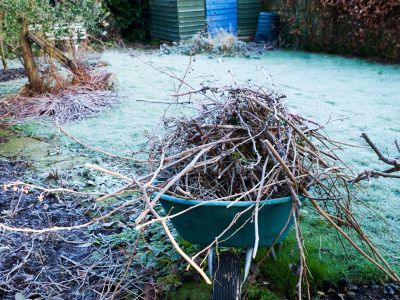Sometimes the amount of work needed after a season of storms and previous seasons’ debris can become overwhelming. It helps to have a list of late winter gardening tips to help focus on the most necessary tasks to promote a vigorous garden.
Why Start End of Winter Garden Maintenance?
The weather may still be frigid or drizzly or just plain stormy, but late winter gardens still need a little TLC to give them a good start for spring. Beginning in late winter to maintain and repair yard damage and debris clears the way for all the spring activity that will soon burst upon the garden. Removing storm waste, raking and amending beds where you can provides open avenues for the next season’s greenery. Pruning, fixing outbuildings, maintaining yard tools and other winter yard chores frees you up in spring to do the fun stuff like starting seeds and planting flower pots and beds. You can take advantage of plant dormancy in late winter gardens and minimize damage with winter pruning. Few things are actively growing in winter, so it is the perfect time to use doing preparatory tasks.
Late Winter Garden Tips
Mid-winter yard chores may include general cleanup but also:
Potting forced bulbs Starting your Allium crops, such as garlic and leeks Planning the vegetable garden and purchasing seeds Spreading organic mulch over perennial fruit and vegetable gardens Trimming off broken and dead branches and stems from trees/shrubs
A bit later in the winter, you may be able to begin turning over beds and adding compost. Garden tasks for end of winter on dry days may include:
Cleaning lawn furniture Fixing and painting window boxes Sharpening and oiling garden tools Plotting the vegetable garden
Late Winter Gardening Tips for Pruning
Almost every plant is best pruned at the end of winter when they are dormant. The largest exceptions are those plants that bloom and fruit off of old wood. These should be pruned after they produce in spring. Pruning when the plant is dormant reduces the loss of life-giving sap from the wounds and cuts tend to heal more quickly than when the tree is actively growing. Pruning is one of the most important gardening tasks for end of winter because it helps promote a strong scaffold, removes impediments to new growth and supports overall good health for the tree. Proper pruning technique requires clean, sharp implements. Cut just outside of branch collars and not into parent wood. Use a slightly angled cut that allows excess moisture to fall of the cut and reduce the chance of rot investing the wound. Remove water sprouts and suckers and open the canopy of thickly branched trees. Take out dead wood and anything that is rubbing against other wood. Try to keep the tree or bush in as natural a habit as possible for best health. End of winter maintenance gives you a chance to get outside and breathe fresh air. It promotes the gardener’s dreams of what will be and the potential of the landscape. Dress warmly and enjoy.
